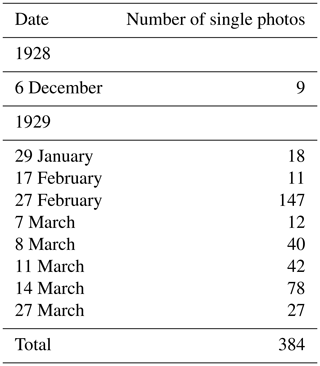the Creative Commons Attribution 4.0 License.
the Creative Commons Attribution 4.0 License.
Early auroral photography and observations at the Sodankylä Geophysical Observatory in Finland, 1927–1929
Heikki Nevanlinna
Eija I. Tanskanen
In Finland, auroral photography started in 1927 at the Sodankylä Geophysical Observatory (SGO) with the initiative of famous Norwegian scientist Carl Störmer. In less than 2 years about 600 photographs of auroras were taken at Sodankylä. Some of the images were obtained simultaneously at auxiliary stations for parallactic determinations of the height of auroral arcs. Most of the pictures of auroras were lost in the destruction of the SGO during the war in 1944. About 200 images were rescued in the archive of the Finnish Meteorological Institute, where they were recently found. These pictures of auroras are the first ones taken in Finland. These photographs are now digitized and archived in the SGO.
During the polar year period 1932–1933, auroral photography was mostly discontinued, but visual observations of auroras were made instead at several sites in Lapland.
The main sources of information about the history of auroral images are handwritten notebooks of Eyvind Sucksdorff for 1927–1929. They contain relevant data for each photograph (date, exposure time, orientation of camera etc.). In Appendix A there are tables showing the dates of rescued auroral photographs as well as the lost ones.
In Finland, Sucksdorff's contribution to studies of auroras was a pioneering effort with minimal resources. Regular photographing of auroras started in Finland during the International Geophysical Year (IGY) 1957–1958.
- Article
(8043 KB) - Full-text XML
- BibTeX
- EndNote
One of the main tasks in the auroral research in the last centuries was the determination of the height of auroral features. For achieving this goal visual observations were usually carried out at different sites using the triangulation technique (Egeland and Burke, 2013). No satisfactory results were achieved in spite of a vast number of scientific efforts. One of the most reliable height determinations was obtained by visual triangulation methods by Sophus Tromholt in Norway in the late 1870s (Moss and Stauning, 2012). Trials of height measurements and photography of auroras were made at the Sodankylä polar year observatory in 1882–1884. Photographs of auroras were unsuccessful because the sensitivity of the films available was too low to expose faint auroral lights. The results of simultaneous visual triangular height measurements of auroras were unrealistic and scattered widely because the baseline was too short (4 km) for accurate determinations of auroral forms observed at both ends of the baseline.
Professor Selim Lemström (1838–1904) (University of Helsinki) published descriptions of several auroral and telluric current experiments carried out at the Sodankylä observatory during the first polar year in 1882–1884 (Lemström, 1883, 1885; Simojoki, 1978).
First successful photographs of auroras were taken in the 1890s in Norway (Egeland and Burke, 2013). This technique opened a new and quantitative way for more exact determinations of the heights of auroral displays.
The Norwegian team of scientists led by the Professor Carl Störmer (1874–1957) maintained in Norway in the 1910s a network of specially designed auroral cameras. The cameras were installed for parallactic positions at two distant sites connected with telephone lines. The distance between the sites was typically 20–70 km. In this setting, the observers could direct their cameras towards the same region of sky and expose at the same time. The location of stars on the photographs fixed the astronomical orientation of auroral forms (Chapman and Bartels, 1940; Störmer, 1930, 1955; Egeland and Burke, 2013).
After analysing thousands of simultaneous photographs, Störmer was able to make the conclusion that the lower border of auroral forms is located about 100 km above the Earth's surface. Using these parallactic auroral photographs, it was possible to determine not only the heights of individual auroral features, but also their locations and orientations in time and space (Chapman and Bartels, 1940; Egeland and Burke, 2013).
The Sodankylä Geophysical Observatory (SGO) (67.35° N, 26.55° E) was founded in 1913 by the Finnish Academy of Sciences, and it was at that time the only magnetic observatory inside the Arctic Circle and thus a suitable place for observations of polar auroras. In the early years of operations, the main tasks of the Sodankylä Geophysical Observatory were continuous magnetic recordings, regional magnetic surveys in Lapland, auroral observations and daily meteorological readings for the Finnish Meteorological Institute in Helsinki. The permanent staff of the observatory consisted of three employees. Eyvind Sucksdorff (1899–1955) was appointed in 1927 as the director of the Sodankylä observatory (Sucksdorff, 1952).
This paper gives a short description of the auroral photography and related observations carried out in the SGO in the 1920s and 1930s. Some of the first auroral photographs are presented as examples of early space weather work.
There was a plan promoted by the scientific community in Norway that the auroral photography network would be expanded outside Norway for the coming polar year 1932–1933. Störmer visited Sodankylä magnetic observatory in September 1927. He proposed to Sucksdorff, who was a skilled photographer and astronomer, that parallactic auroral photographs should be started in northern Finland to extend the auroral photograph network in Norway in cooperation between Finnish and Norwegian scientists for the International Polar Year programme. As planned by Störmer, photography of auroras started in Sodankylä and in a nearby station in November 1927.
Störmer's auroral camera consisted of a glass plate (10 × 14 cm) coated with photographic emulsion. The lens of the camera was manually movable in such a manner that six individual photographs could be taken on the same plate. The Norwegian auroral cameras were not suitable for taking all-sky pictures because the field of view was typically limited to about 25 × 25° on the sky. The exposure time was selected according to the brightness of auroras visible on the sky. Usually the time was 1–30 s.
For less than 2 years in 1927–1929, Sucksdorff and his assistants took about 600 photographs of auroras at the SGO using cameras designed by the Störmer's scientific team. A few photos were taken at the auxiliary stations. The major part of these photos were lost during the war in 1944 when German military troops totally destroyed all the buildings and archive of the Sodankylä Geophysical Observatory (Sucksdorff et al., 2001; Bösinger, 2021). However, paper copies of about 200 photographs were archived before the war in the library of the Finnish Meteorological Institute in Helsinki. Recently, this historical material was found, and the present presentation is based on this collection of pictures of auroras.
First parallactic auroral photographs were taken simultaneously at the Sodankylä observatory and at the auxiliary station Kelujärvi, some 20 km to the north of the observatory. Both sites were connected by a telephone line for simultaneous communications during the operations with cameras. Up to the end of 1927 more than 100 auroral pictures had been taken at the Sodankylä observatory alone.
Figure 1 shows the Norwegian aurora camera on the top of the main building of the Sodankylä Geophysical Observatory in the early 1930s.
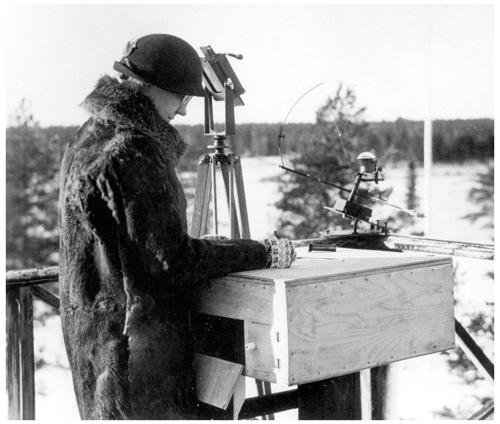
Figure 1Annikki Sucksdorff (1904–1986) was the assistant of the Sodankylä Geophysical Observatory during 1927–1945 (Sucksdorff, 1952). In the photograph she is working with auroral observations on the roof of the observatory building. A Störmer camera is in the front of her. The river Kitinen can be seen in the background (photo: Finnish Meteorological Institute).
The first simultaneous photographs at Sodankylä and Kelujärvi sites were taken in January 1928. In one night more than 20 successful exposures were captured on films. They were sent to Störmer's laboratory at the University of Oslo for determination of auroral heights using a specially constructed projector for the photographs. Such a device was not in use in Sodankylä. Unfortunately, no information exists about the results of the height analysis in Oslo.
In the winter of 1927–1928 there were nine nights suitable for photographing at the Sodankylä observatory, and almost 200 auroral photographs were taken. In the winter of 1928–1929 the number of auroral pictures collected was almost 400 (for a list of dates, see Appendix A). Later in the 1930s auroral photography was only a minor part of the work at the Sodankylä observatory and very few pictures were taken.
The auroral images available have been digitized. They can be found in the digital archive of the SGO together with the supporting metadata information in Nevanlinna and Tanskanen (2024). The URL address is https://sgo.fi/Data/Optical/SGOHistAurObs/Sucksdorff1927_1929/index.php (last access: 17 June 2024).
Figures 2 and 3 show examples of historical images of auroras at Sodankylä taken in March 1928. They belong to the first photographs of auroras in Finland. Figure 4 depicts simultaneous auroral arcs at Sodankylä observatory and at the auxiliary site Kelujärvi, some 20 km north of Sodankylä.
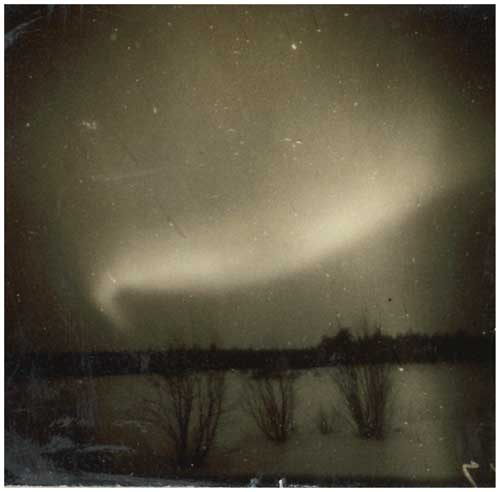
Figure 2An auroral arc photographed at Sodankylä observatory on 13 March 1928 20:32 UT. Faint spots on upper left corner belong to the star cluster Pleiades in the constellation of Taurus. The exposure time was 39 s. The centre of the photo is towards the west and about 30° from the horizon (photo: Eyvind Sucksdorff's collection, SGO).

Figure 3An auroral arc at the Sodankylä observatory on 13 March 1928 20:13 UT. The bright star on the centre is Arcturus in the constellation of Boötes. The exposure time was 9 s. The centre of the photo is towards the east and about 20° from the horizon (photo: Eyvind Sucksdorff's collection, SGO).
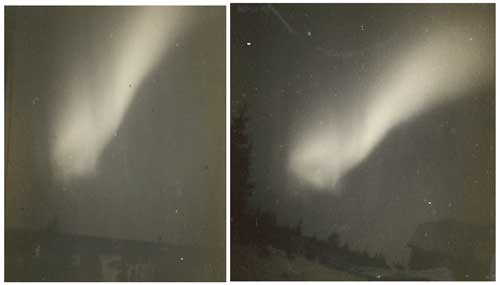
Figure 4Left: auroral arc at Sodankylä on 27 January 1928 19:25 UT. Right: the same at the auxiliary station Kelujärvi, 20 km from Sodankylä. The exposure time was 25 s. The lower edge of the auroral form is about 20° above the horizon towards the brightest stars of the constellation Pegasus in the west. One such star (α Pegasi) can be seen in the lower right corner in both images (photo: Eyvind Sucksdorff's collection, SGO).
The period 1927–1929, during which photographs of auroras were taken at the Sodankylä observatory, coincided with the maximum phase of the sunspot cycle 16. The 27 February 1929 magnetic storm observed at the SGO and other magnetic stations at high latitudes was one of the major magnetic storms during the solar cycle 16 (1923–1933) (e.g. Goldie, 1929; Rowland, 1929; Newton, 1930). According to the visual observations made by Sucksdorff, this storm started around 17:30 UT with a magnificent discrete auroral display (so-called corona) at the zenith covering the sky from east to west. A new corona appeared at midnight, illuminating the snow-covered landscape. First magnetic signals of the storm occurred one day earlier on 26 February around midnight (Fig. 5). During the most intensive period of the storm around midnight 27–28 February, the magnetic 3 h K index increased up to (K= 8 corresponds to amplitudes 990 nT < ΔH < 1500 nT and ΔH > 1500 nT when K= 9) as derived from the Sodankylä magnetic records. The greatest deviation in the hourly means of the magnetic north component (X) was about 1000 nT in the late evening on 27 February (Fig. 5).
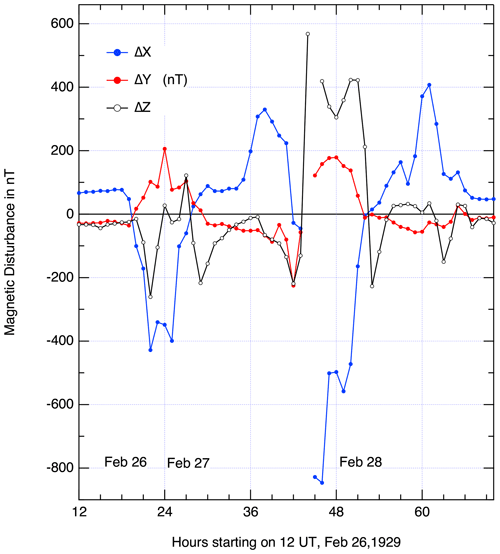
Figure 5Three component (X, Y, Z) hourly magnetic variations as reproduced from the magnetic recordings of the Sodankylä Geophysical Observatory from 26–28 February 1929. The daily local activity index (Ak) for 29 February was 79. The main phase of the magnetic auroral storm occurred around midnight on 27–28 February. The first signals of the storm appeared in late evening on 26 February. Hourly values are from the SGO magnetometer data archive.
The two top pictures show auroral lights reflected from the frozen river Kitinen. The black belt under the auroral lights, which is the tree line on the other side of the river, is seen in all pictures, most clearly in the top row. Next four pictures show rapidly changing auroral forms, veils and spirals. Two bright spots are planets Jupiter (upper) and Venus (lower) in the west and about 15° from the horizon (photo: Eyvind Sucksdorff's collection, SGO).
Figure 6 shows an example of temporal changes of the auroral storm of 27 February as recorded by the auroral camera in a short time interval of about 5 min. There are six single pictures captured on the same glass plate taken in about 30 s intervals. In the figure one can see bright veils and patches of auroras as well as spiral shapes. In the background of auroral lights there are two bright planets: Venus and Jupiter.
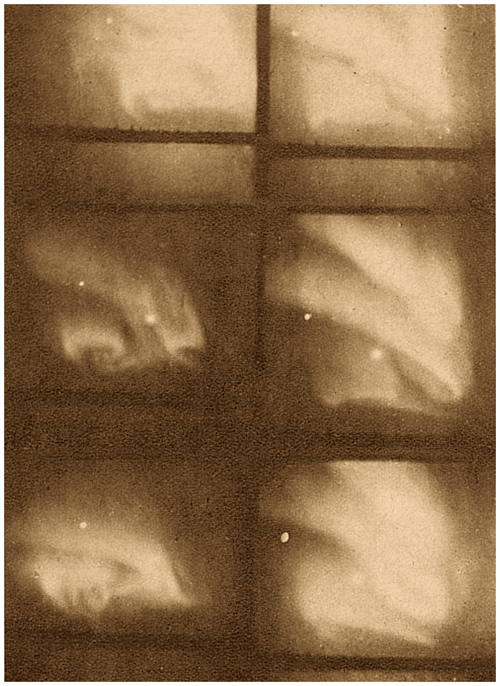
Figure 6Auroral displays on 27 February 1929 as captured by a camera at the Sodankylä Geophysical Observatory. The times (hh:mm:ss in UT) for the six photographs and the exposure times (in brackets) are as given. First row from left to right: 18:28:01 (16) and 18:28:39 (8); second row: 18:28:57 (11) and 18:29:38 (11); third row: 18:31:04 (9) and 18:32:40 (12).
In addition to the photographs in Fig. 6, there are available two more plates both including six single images of auroras starting at 18:22 and 20:23 UT. The remaining 147 auroral photographs, taken during the 27 February storm (17:00–24:00 UT), were lost in the destruction of the SGO during the war in 1944 (see Appendix A).
Störmer and his colleagues were able to take simultaneous photographs of auroras at two sites near Oslo (Norway) during the nights in 26–28 February 1929. The number of usable photographs obtained was over 100. A sample of images was published together with height analysis of auroral forms (Störmer, 1930; Chapman and Bartels, 1940, Vol. I, p. 462). Based on calculations from two simultaneous images from early morning hours on 27 February, the height of the lowest border of auroras was located at an altitude of 82 km.
The 27 February 1929 storm was reported in many contemporary newspapers in Finland and in international scientific studies (e.g. Goldie, 1929; Rowland, 1929; Ulrich, 1929; Newton, 1930; Chapman and Bartels, 1940; Störmer, 1930, 1955).
For the International Polar Year 1932–1933, the scientific programme of the Sodankylä Geophysical Observatory was extended by new observations such as earth currents, atmospheric electricity and magnetic pulsations (Sucksdorff, 1952; Bösinger, 2021). SGO was equipped with modern magnetic registration devices provided by the Danish Meteorological Institute and designed by Dan Barfod la Cour, who was the president of the International Polar Year programme and the director of the Danish Meteorological Institute. With his initiative Sodankylä observatory was selected as a training place for the scientists involved with magnetic measurements in the Arctic.
Two temporary observatories during the polar year 1932–1933 were set up in Finland. They were Petsamo (69.5° N, 31.2° E) near the coast of the Arctic Sea, now in the territory of Russia, and Kajaani in eastern Finland (64.2° N, 27.7° E) (Tommila, 1937; Sucksdorff et al., 2001).
Systematic observations of auroras by means of visual sightings were also included in the programme. One goal of this work was to achieve a more accurate description of the occurrence of auroras and magnetic variations both in time and space around Earth's Arctic area.
Sucksdorff introduced special graphical symbols for different types of auroras for the International Polar Year plan of visual observations. About 20 different symbols indicated various manifestations of auroral shapes, colours and their occurrence times. Sucksdorff made visual observation of auroras during the International Polar Year 1932–1933 that were continued observations up to 1944 at the Sodankylä Geophysical Observatory. The material accumulated contains coded information of auroral appearances from about 750 nights. The original handwritten data are stored in the archive of the SGO. The relevant information of this unpublished data set is included in the compilation of the auroral pictures by Nevanlinna and Tanskanen (2024).
Because the results of the simultaneous photography of auroral arcs during 1927–1929 were not very successful, Sucksdorff developed a simple visual method instead. He constructed a special aiming device, called a quadrant, by which the height of well-defined and stable auroral arcs could be determined visually (Fig. 7). The height of arcs, as measured in elevation angles from the horizon, was read from a scale attached on the quadrant. Sucksdorff organized coordinated campaigns in Lapland in which 12 volunteer observers, like schoolteachers, made sightings with the quadrant at different places. If two or more observers measured the same arc at the same time, its true height could be determined. Although it was known already in the 1910s that the average height of lower edge of auroral forms is about 100 km, it was not clear how low the aurora lights could occur in extreme auroral cases (Störmer, 1930; Chapman, 1932). One of the goals of Sucksdorff's campaign was to search for these supposed low-altitude auroras.

Figure 7Sucksdorff demonstrates a device (quadrant) for visual determination of the height of auroral arcs. It consists of a thin wooden plate with a scale and a plumb line suspended to the plate showing the elevation angle of auroral arcs visible. The observer turns the quadrant until the upper edge of the plate points to the arc of an auroral display (photo: Finnish Meteorological Institute).
Visual observations were made during the polar year period and continued at some places up to 1936. At an auxiliary station scientists from the Danish Meteorological Institute made continuous observations of auroras up to 1936 as planned by Sucksdorff and maintained magnetic recordings. However, the result of several years of measurements was that only little relevant information about the appearance of simultaneous auroral arcs was revealed in the observations of accurate calculations of the location and height of auroral arcs. The observations collected have not been analysed, but the whole material is now in the archive of the SGO.
Visual observations of the occurrence of auroras have been made in connection with daily meteorological observations at Sodankylä since the founding of the observatory in 1914. Such routine observations were continued until 1954 when auroral observations were removed from the daily meteorological readings. The 40-year period of visual observations of auroras provides some information of the long-term variations in the occurrence rate of auroras. There were more than 1800 nights with auroras during 1914–1954 in Sodankylä (see Appendix B). Figure 8 shows the annual number of nights illuminated by auroras during clear-sky conditions at Sodankylä. Also shown are annual sunspot numbers and local magnetic activity (Ak). In Fig. 8 the annual occurrence rates of auroras at Sodankylä are compared with annual number of low-latitude (geomagnetic latitude < 57°) auroras obtained from a compilation by Legrand and Simon (1987). One can see that the annual numbers of auroral nights, from local and low-latitude observations, follow the magnetic activity and varying sunspot numbers in the course of an 11-year sunspot cycle moderately well. The changes from year to year seem to vary in such a way that the largest number of auroral nights are seen during the declining solar cycle phase. However, there are certain anomalies in the auroral variation at the SGO compared with magnetic activity and low-latitude auroral occurrences. This is probably due to varying weather and cloudy conditions, but certain non-geophysical factors have also contributed to the inhomogeneity of the results based on visual auroral observations (Lockwood et al., 2018). Correlation between annual auroral occurrence rate at the SGO and local magnetic activity is rather low, 0.51.
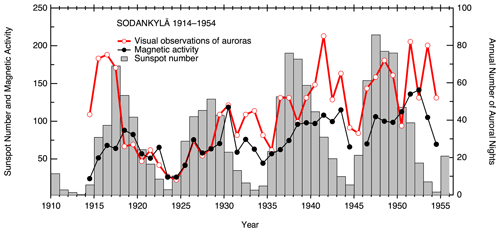
Figure 8Red: time variations in the number of auroral nights obtained by visual observations of auroras at Sodankylä during 1914–1954 (data: meteorological yearbooks – Finnish Meteorological Institute). Blue: annual number of visual auroras at subauroral latitudes (data: Legrand and Simon, 1987). Dotted black: annual means of local magnetic activity index Ak (multiplied by a factor of 3) (data: magnetic yearbooks – Sodankylä Geophysical Observatory). Histograms: annual sunspot numbers (data: Solar Influences Data Analysis Center, WDC-SILSO).
Tanskanen et al. (2005) and Tanskanen (2009) found that the largest substorm numbers and peak amplitudes were found during the declining solar cycle phases. This is similar to conclusion here that auroral occurrence rate is generally enhanced during the declining phase of a solar cycle. In addition there seems to be an increasing multi-decadal trend in the annual number of auroral nights connected with similar increasing tendency in the long-term magnetic activity and the peak numbers of sunspots ultimately associated with solar processes and the interplanetary magnetic field (e.g. Mayaud, 1972; Lockwood, 2001, 2014). The long-term trend in the annual auroral occurrence rates shown in Fig. 8 may be connected with the centennial Gleissberg cycle of solar activity (e.g. Feynman and Ruzmaikin, 2014; Le Mouël et al., 2017).
Numerical values of the data shown in Fig. 8 are given in Appendix B.
Although no significant scientific results were obtained from the aurora images taken at the Sodankylä Geophysical Observatory in 1927–1929, the cooperation with leading Norwegian scientists yielded a new area for the observatory's operations and contacts with the scientific community outside Finland. Photographs of auroras obtained almost 100 years ago are the first ones in Finland. The entire observational material (except for that lost during the war in 1944) collected in the 1920s and 1930s can be found in an open-access repository at the SGO.
The dates of auroral photography are given in Appendix A.
In Finland, Sucksdorff was quite alone in auroral studies in the 1920s and 1930s. He had to work with very limited resources, but the results were important for future auroral work in Finland. The situation was totally different in Norway, where several outstanding scientists with high reputations in the scientific community, such as Kristian Birkeland, Carl Störmer, Ole Krogness, Lars Vegard, Leiv Harang and many others, were involved with observations and scientific studies of aurora and related cosmic phenomena. Space physics has been in the teaching programme in several Norwegian universities and institutions since the 1910s. In Finland, there was no academic teaching or research at all in these fields before the 1950s.
Regular auroral photography was restarted during the IGY (International Geophysical Year) 1957–1958, when a modern Stoffregen-type all-sky camera, constructed in the Finnish Meteorological Institute by Eyvind Sucksdorff's son Christian (1928–2016), was set up at the Sodankylä Geophysical Observatory (Nevanlinna and Pulkkinen, 2001; Schlegel and Lühr, 2014; Bösinger, 2021).
Table B1Annual numbers of auroral nights1 at the SGO 1914–1954, local magnetic activity index2 (Ak), sunspot number3 (R) and global auroral occurrence number4 (AO).
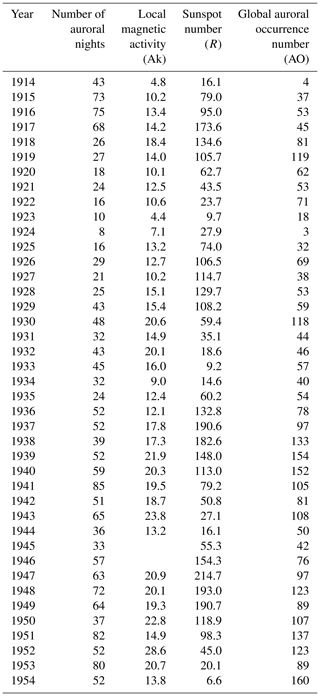
1 Finnish Meteorological Institute – meteorological yearbooks.
2 Sodankylä Geophysical Observatory – magnetic yearbooks.
3 Solar Influences Data Analysis Center, WDC-SILSO.
4 Based on auroral data compiled by Legrand and Simon (1987).
The original handwritten data are stored in the archive of the SGO, but the relevant information of this unpublished data set is included in the compilation of the auroral pictures at https://sgo.fi/Data/Optical/SGOHistAurObs/Sucksdorff1927_1929/index.php by Nevanlinna and Tanskanen (2024).
The first author HN collected and digitized the auroral pictures found in the archive of the Finnish Meteorological Institute. HN provided the background metadata information of the auroral pictures. Both authors wrote the final text and compiled the collection of auroral pictures with metadata.
The authors declare that they have no conflict of interest.
Publisher’s note: Copernicus Publications remains neutral with regard to jurisdictional claims made in the text, published maps, institutional affiliations, or any other geographical representation in this paper. While Copernicus Publications makes every effort to include appropriate place names, the final responsibility lies with the authors.
This article is part of the special issue “History of geophysical institutes and observatories”. It is not associated with a conference.
This work was partly supported by the Academy of Finland (Solstice Project no. 324161).
This research has been partly supported by the Academy of Finland (Solstice Project no. 324161).
This paper was edited by Hisashi Hayakawa and reviewed by three anonymous referees.
Bösinger, T.: The Geophysical Observatory in Sodankylä, Finland – past and present, Hist. Geo Space. Sci., 12, 115–130, https://doi.org/10.5194/hgss-12-115-2021, 2021.
Chapman, S.: Low altitude auroras, Nature, 130, 764–765, https://doi.org/10.1038/130764a0, 1932.
Chapman, S. and Bartels, J.: Geomagnetism, Vol. I & II, Oxford, Clarendon Press, 1940.
Egeland, A. and Burke, W. J.: Carl Störmer, Auroral Pioneer, Springer Astrophysics and Space Science Library, 393, 195 pp, ISBN 978-3-642-31456-8, 2013.
Feynman, J. and Ruzmaikin, A.: The centennial Gleissberg cycle and its association with extended minima, J. Geophys. Res.-Space, 119, 6027–6041, https://doi.org/10.1002/2013JA019478, 2014.
Goldie, A. H. R.: Magnetic Storm of Feb. 26–28, 1929, Nature, 123, 494, https://doi.org/10.1038/123494b0, 1929.
Legrand, J.-P. and Simon, P. A.: Two hundred years of auroral activity (1780–1979), Ann. Geophys., 5, 161–167, 1987.
Le Mouël, J.-L., Lopes, F., and Courtillot, V.: Identification of Gleissberg cycles and rising trend in a 315-year long series of sunspot numbers, Sol. Phys., 292, 1–9, https://doi.org/10.1007/s11207-017-1067-6, 2017.
Lemström, S.: The Aurora Borealis, Nature, 28, 60–62, https://doi.org/10.1038/028060a0, 1883.
Lemström, S.: The results of the scientific expedition to Sodankylä, Nature, 31, 372–376, https://doi.org/10.1038/031372a0, 1885.
Lockwood, M.: Long-term variations in the magnetic fields of the Sun and the heliosphere: Their origin, effects and implications, J. Geophys. Res., 106, 16021–16038, https://doi.org/10.1029/2000JA000115, 2001.
Lockwood, M.: Long-term variations in the magnetic fields of the Sun and the heliosphere: Their origin, effects, and implications, J. Geophys. Res., 106, 16021–16038, https://doi.org/10.1029/2000JA000115, 2014.
Lockwood, M., Bentley, S. N., Owens, M. J., Barnard, L. A., Scott, C. J., Watt, C. E., Allanson, O., and Freeman, M. P.: The development of space climatology: 2 – The distribution of power input into the magnetosphere on a 3-hourly timescale, Space Weather, 17, 157–179, https://doi.org/10.1029/2018SW002016, 2018.
Mayaud, P. N.: The aa Indices: A 100-year series characterizing the magnetic activity, J. Geophys. Res., 77, 6870–6874, https://doi.org/10.1029/JA077i034p06870, 1972.
Moss, K. and Stauning, P.: Sophus Peter Tromholt: an outstanding pioneer in auroral research, Hist. Geo Space. Sci., 3, 53–72, https://doi.org/10.5194/hgss-3-53-2012, 2012.
Nevanlinna, H. and Pulkkinen, T. I.: Auroral observations in Finland – Results from all-sky cameras 1973–1997, J. Geophys. Res., 106, 8109–8118, https://doi.org/10.1029/1999JA000362, 2001.
Nevanlinna, H. and Tanskanen, E. I.: Compilation of historical auroral pictures and supporting metadata information, Sodankylä Geophysical Observatory (SGO) [data set], https://sgo.fi/Data/Optical/SGOHistAurObs/Sucksdorff1927_1929/index.php (last access: 17 June 2024), 2024.
Newton, H. W.: Magnetic storms and solar activity during 1929, The Observatory, 53, 77–79, 1930.
Rowland, J. P.: Magnetic Storm of Feb. 27–28. Nature, 123, 450, https://doi.org/10.1038/123450b0, 1929.
Schlegel, K. and Lühr, H.: Willy Stoffregen – An early pioneer of advanced ionospheric and auroral research, Hist. Geo Space. Sci., 5, 149–154, https://doi.org/10.5194/hgss-5-149-2014, 2014.
Simojoki, H.: The History of Geophysics in Finland, The History of Learning and Science in Finland 1828–1918, 5b, Societas Scientiarum Fennica, 157 pp. ISBN 951-653-078-8, 1978.
Störmer, C.: Wie tief dringen die Polarlichter ein?, Zeitschrift für Geophysik, 6, 334–340, https://doi.org/10.23689/fidgeo-3212, 1930.
Störmer, C.: The polar aurora, Oxford University Press, 403 pp., 1955.
Sucksdorff, C., Bösinger, T., Kangas, J., Mursula, K., Nygrén, T., Kauristie, K., and Koskinen, H.: Space Physics, Geophysica, 37, 209–355, 2001.
Sucksdorff, E.: The Geophysical Observatory Sodankylä, Geophysica, 5, 17–47, 1952.
Tanskanen, E. I.: A comprehensive high-throughput analysis of substorms observed by IMAGE magnetometer network: Years 1993-2003 examined, J. Geophys. Res.-Space, 114, A05204, https://doi.org/10.1029/2008JA013682, 2009.
Tanskanen, E. I., Slavin, J. A., Tanskanen, A. J., Viljanen, A. Pulkkinen, T. I., Koskinen, H. E. J., Pulkkinen, A., and Eastwood, C.: Magnetospheric substorms are strongly modulated by interplanetary high-speed streams, Geophys. Res. Lett., 32, L16104, https://doi.org/10.1029/2005GL023318, 2005.
Tommila, M.: Ergebnisse der magnetischen Beobachtungen des Polarjahr-Observatoriums zu Petsamo im Polarjahre 1932–1933, Veröffentlichungen des Geophysikalischen Observatoriums der Finnischen Akademie der Wissenschaften – Spezielle Untersuchungen von dem Internationalen Polarjahre 1932–1933, Nr. 1, 1937.
Ulrich, F. P.: Principal magnetic storms - Sitka magnetic observatory, January to March, 1929, J. Geophys. Res., 34, p. 261, https://doi.org/10.1029/TE034i003p00261, 1929.
- Abstract
- Introduction
- First auroral photographs at Sodankylä
- Great magnetic storm, 27 February 1929
- Visual observations of auroras during the polar year 1932–1933
- Discussion
- Appendix A
- Appendix B
- Data availability
- Author contributions
- Competing interests
- Disclaimer
- Special issue statement
- Acknowledgements
- Financial support
- Review statement
- References
- Abstract
- Introduction
- First auroral photographs at Sodankylä
- Great magnetic storm, 27 February 1929
- Visual observations of auroras during the polar year 1932–1933
- Discussion
- Appendix A
- Appendix B
- Data availability
- Author contributions
- Competing interests
- Disclaimer
- Special issue statement
- Acknowledgements
- Financial support
- Review statement
- References






